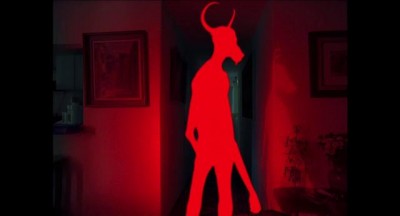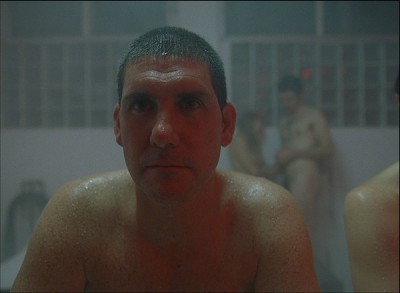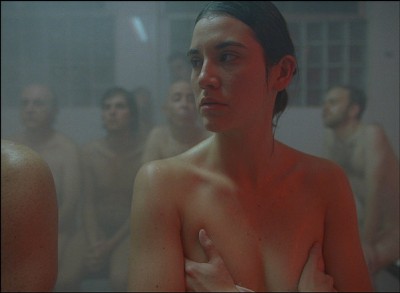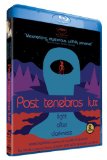| Reviews & Columns |
|
Reviews DVD TV on DVD Blu-ray 4K UHD International DVDs In Theaters Reviews by Studio Video Games Features Collector Series DVDs Easter Egg Database Interviews DVD Talk Radio Feature Articles Columns Anime Talk DVD Savant Horror DVDs The M.O.D. Squad Art House HD Talk Silent DVD
|
DVD Talk Forum |
|
|
| Resources |
|
DVD Price Search Customer Service #'s RCE Info Links |
|
Columns
|
|
|
Post Tenebras Lux
THE MOVIE:
Please Note: The stills used here are taken from promotional materials and other sources, not the Blu-ray edition under review.

I'm a bit stymied how to even begin approaching this one. As a fan of all kinds of obtuse, high-concept art films, from Jean-Luc Godard to Seijun Suzuki to Apichatpong Weerasethakul to probably a lot of stuff a lot of you guys hate and adore with equal fervor, I'm certainly part of the core demographic that should appreciate Mexican director Carlos Reygadas' jumbled family drama Post Tenebras Lux, but having viewed the film the first time, I have come out the other side strangely unmoved.
Post Tenebras Lux opens in an intriguing fashion. After an initial sequence following a little girl through a field where cows and horses graze and energetic dogs nip at their hooves, we are introduced to Juan (Adolfo Jiménez Castro) and Natalia (Nathalia Acevedo) and their two young kids (played by the director's own chidlen). It's their daughter, Rut, who was out in the field, which may have just been a dream. So, too, might we question the reality of the scene linking these two bits, in which a naked red devil returns after a long day's work. Is this another fantasy, or is it the demon Juan having come home to roost? He certainly has his issues, including violent proclivities and a porn addiction. Before we can get our bearings, however, Reygadas jumps ahead in time, showing us a broken version of Juan being persecuted at a family reunion, and then an even older iteration taking his lonely, unsatisfied wife to a sex club, where he watches her find pleasure as part of a fleshy tableau vivant. In the "Duchamp Room," no less. Talk about a bride stripped bare!
Peel away these disjointed scenes and some of the equally odd moments that occur at intervals throughout the film (including British schoolboys playing rugby) and set them aside, and you are left with the sort of plot that lends itself to a more traditional summary. Though Juan's abuses and self-centeredness threaten to ruin his family, his hiring of a reformed criminal and recovering alcoholic to work his land leads to more tragic consequences. While the bad-luck-charm handyman, ironically nicknamed Seven (Willebaldo Torres), can't seem to escape his true nature, he becomes the catalyst for Juan seeing the light (at least figuratively), living out a Tolstoy quote Juan threw out earlier that suggests a man can only truly appreciate what he has after he's lost it.

This aspect of the story is easy to understand, and it works as a thin, yet facile, character study. The title of the film, Post Tenebras Lux, translates loosely as "And after darkness, light." This would be the prevailing theme of Reygadas' motion picture: from tragedy, peace can emerge. Not that knowing this actually illuminates other aspects of the auteur's puzzling narrative. The closest thing to another clue can be found waiting out on the rugby field, and it's basically the last line of the movie. One player gives a pep talk, insisting his team can win because they are a team, while their opponents are individuals acting toward their own selfish ends. Likewise, if one compares Juan and Seven and where they are in terms of family. The man without tries to take away for the man with.
Reygadas and cinematographer Alexis Zabe, who also worked together on Silent Light, shot Post Tenebras Lux at the traditional old-Hollywood aspect ratio of 1.37:1, or what we might today call "full frame," even if widescreen TVs now means the actual frame is only the center square. The pair applies a filter to the lens so that the edges are out of focus, creating a ghostly haloing effect when characters move toward either side of the image. The photography itself is beautiful, but the aesthetic choice to warp the picture seems to be a deliberate attempt to keep the audience off-kilter, always slightly removed from the "reality" of the fiction being portrayed, consistently aware of the illusion.
It's effective, to be sure, but I find myself asking to what end. What am I supposed to be feeling when Post Tenebras Lux goes to closing credits? What is the sum of all these parts meant to tell me? My suspicion is not much, that the pieces just don't add up, though even if I accept that as my conclusion, effectively handing in my Pretentious Git membership card, it's also hard to dismiss Post Tenebras Lux completely. It unmistakably gets under the skin, it's most unnerving achievement being creating that exact nagging self-doubt, causing me to fret over whatever it was that maybe I missed.* One could almost call it a Mexican Upstream Color, a movie that fascinates and somehow entertains, all the while glossing over the emptiness of the exercise. I don't hate either of those films, but I also find myself being less and less concerned with figuring out their secrets the longer I let the material settle. After the darkness, what we see is merely what we get.
* It also has one of the most genuinely disturbing "shock" moments I've seen in a movie in all of 2013, though to divulge too much might be a "spoiler." It's the penultimate scene of the film.
NOTE: For an alternative point of view, Christopher McQuain gave high marks to the DVD back in August.

THE BLU-RAY
Video/Sound:
The studio has not provided DVDTalk with a final-version retail release for review; rather, they have sent a loose disc, minus the packaging, that may or may not reflect the actual product.
That said, what is available to me looks quite good, with a high-definition transfer (1080p) that works with the unique look of the film to bring out vivid detail, adjusting to the light and the dark and preserving some of the more quirky aspects of the cinematography, including scratches and pops that mimic home movies. Light is given focused attention, allowing viewers to appreciate how it moves and dims and sets a scene. Dark blacks looks good, while the red devil burns hot. The multi-lingual soundtrack is given two different mixes, a 5.1 DTS-HD Master Audio track and a LPCM 2.0 track. This is a mostly quiet movie, but what I hear on the advance disc shows the same attention to detail given the image, letting the subtle magic of the sound design work as intended.
Optional English subtitles are provided, and they are easy to read, despite the occasional grammar issue.
Extras:
Extra features on the disc appear limited, including the expected theatrical trailer alongside other previews for Strand Releasing films.
A quartet of deleted scenes of varying lengths do little to unlock the mysteries of the movie. As one would assume, they are non-essential trims.
A 33-minute video diary takes viewers through the locations in the film and gathers unguarded moments on set, such as children at play, setting up shots and rehearshing, and the crew hanging out.
FINAL THOUGHTS:
Let me put on my cheesy critic's cap for a second. Imagine I am writing for a small-town newspaper and am looking to put a stinger onto a difficult review: When it comes to Post Tenebras Lux, some will be struck by the light watching this film, others will be left out in the dark. Carlos Reygadas has crafted an intentionally perplexing movie, and I'd almost wager that he'd be just as pleased by my reaction as he would be by the other folks who have been gushing over it since he took the director prize at Cannes. As with anything, your mileage is going to vary, but follow your gut. If you like abstraction and ambiguity, you may just have found your new favorite movie. Hell, you never know, a year or more down the line, I may watch Post Tenebras Lux again and decide it's my favorite. This kind of stuff is amorphous. Thus, I suggest you minimize the risk and Rent It if you're keen to find out for yourself.

Jamie S. Rich is a novelist and comic book writer. He is best known for his collaborations with Joelle Jones, including the hardboiled crime comic book You Have Killed Me, the challenging romance 12 Reasons Why I Love Her, and the 2007 prose novel Have You Seen the Horizon Lately?, for which Jones did the cover. All three were published by Oni Press. His most recent projects include the futuristic romance A Boy and a Girl with Natalie Nourigat; Archer Coe and the Thousand Natural Shocks, a loopy crime tale drawn by Dan Christensen; and the horror miniseries Madame Frankenstein, a collaboration with Megan Levens. Follow Rich's blog at Confessions123.com.
|
| Popular Reviews |
| Sponsored Links |
|
|
| Sponsored Links |
|
|
| Release List | Reviews | Shop | Newsletter | Forum | DVD Giveaways | Blu-Ray | Advertise |
|
Copyright 2024 DVDTalk.com All Rights Reserved. Legal Info, Privacy Policy, Terms of Use,
Manage Preferences,
Your Privacy Choices | |||||||













